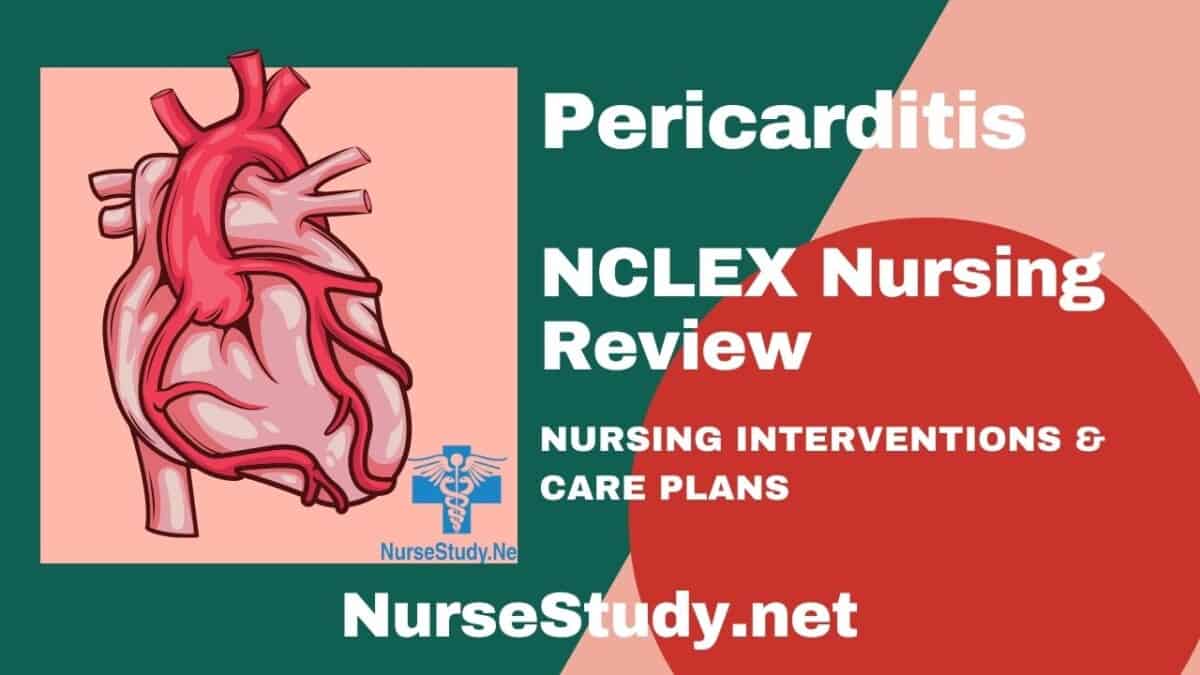Pericarditis is the inflammation of the pericardium, the protective, double-layered sac that surrounds the heart. This condition causes sharp, pleuritic chest pain that often radiates to the neck, shoulders, or back and is typically relieved when the patient leans forward.
For nurses, recognizing pericarditis is crucial because early intervention can relieve pain, prevent complications, and improve cardiac function.
Definition
Pericarditis is defined as inflammation of the pericardial membranes that may lead to fluid accumulation (pericardial effusion). It can be acute (developing suddenly and lasting days to weeks) or chronic (lasting longer than three months).
Causes and Risk Factors
- Infectious causes: Viral infections such as Coxsackievirus, influenza, and HIV.
- Non-infectious causes: Autoimmune disorders (systemic lupus erythematosus, rheumatoid arthritis), post-cardiac surgery, trauma, radiation, or malignancy.
- Metabolic causes: Uremia and hypothyroidism.
- Medication-induced: Hydralazine, isoniazid, and procainamide.
Pathophysiology
Inflammation of the pericardial layers causes capillary leakage and fluid buildup within the pericardial sac. The resulting friction leads to the characteristic pericardial friction rub heard on auscultation. This inflammation irritates pain receptors, causing sharp, stabbing chest pain that worsens when lying flat.
Assessment Findings
- Sharp, stabbing chest pain that increases with inspiration or lying supine and improves when leaning forward
- Pericardial friction rub heard over the left lower sternal border
- Low-grade fever and fatigue
- Dyspnea or shallow breathing
- ECG changes: diffuse ST-segment elevation or PR depression
- Elevated inflammatory markers (ESR, CRP)
- Possible mild elevation in troponin
Diagnostic Tests
- 12-lead ECG: Diffuse ST-segment elevation across multiple leads
- Echocardiogram: To assess pericardial fluid
- Chest X-ray: May show an enlarged cardiac silhouette
- Laboratory studies: CBC, ESR, CRP, and cardiac enzymes
Nursing Care Plans for Pericarditis
Nursing Care Plan #1 – Acute Pain
Nursing Diagnosis: Acute pain related to pericardial inflammation as evidenced by reports of chest pain and guarding behavior.
Nursing Interventions and Rationales
- Position the patient in a high Fowler’s or leaning-forward position to reduce pericardial friction.
- Administer prescribed NSAIDs or colchicine for pain and inflammation.
- Encourage rest and limited activity to reduce myocardial oxygen demand.
- Provide a calm environment and reassurance to minimize anxiety that can exacerbate pain perception.
Desired Outcomes
The patient reports pain relief, demonstrates relaxed posture, and verbalizes understanding of pain-management strategies.
Nursing Care Plan #2 – Ineffective Breathing Pattern
Nursing Diagnosis: Ineffective breathing pattern related to pain on inspiration and pericardial inflammation.
Nursing Interventions and Rationales
- Elevate the head of the bed to ease breathing and lung expansion.
- Monitor respiratory rate, effort, and oxygen saturation.
- Administer supplemental oxygen if indicated.
- Encourage slow, shallow breathing techniques to promote relaxation and reduce discomfort.
Desired Outcomes
Respiratory rate and effort return to baseline; patient demonstrates improved comfort with minimal distress.
Nursing Care Plan #3 – Decreased Cardiac Output
Nursing Diagnosis: Decreased cardiac output related to pericardial inflammation, interfering with normal cardiac filling.
Nursing Interventions and Rationales
- Monitor vital signs, heart rate, and rhythm regularly.
- Assess for dizziness, fatigue, and hypotension, indicating reduced perfusion.
- Administer medications as prescribed and monitor response.
- Encourage fluid balance and monitor intake/output closely.
Desired Outcomes
Stable heart rate and blood pressure with improved energy levels and perfusion.
Nursing Care Plan #4 – Anxiety
Nursing Diagnosis: Anxiety related to chest pain and fear of cardiac illness.
Nursing Interventions and Rationales
- Provide factual information about the condition and its management.
- Encourage questions and participation in care decisions.
- Offer reassurance and emotional support to reduce fear.
- Teach relaxation and breathing exercises.
Desired Outcomes
The patient demonstrates reduced anxiety, verbalizes understanding of the condition, and participates in care.
Nursing Care Plan #5 – Knowledge Deficit
Nursing Diagnosis: Deficient knowledge related to new diagnosis and treatment regimen.
Nursing Interventions and Rationales
- Educate about medication use (NSAIDs, colchicine), possible side effects, and the importance of adherence.
- Teach to avoid strenuous activities until cleared by a healthcare provider.
- Emphasize the importance of follow-up visits and ECG monitoring.
- Instruct to report recurrence of chest pain or shortness of breath promptly.
Desired Outcomes
The patient verbalizes understanding of the treatment plan and demonstrates correct self-care behaviors.
Patient Education & Safety Tips
- Encourage adequate rest during recovery.
- Avoid strenuous exercise until inflammation resolves.
- Adhere to the medication regimen to prevent recurrence.
- Maintain follow-up appointments for ongoing evaluation.
Frequently Asked Questions
1. What causes pericarditis?
It is commonly caused by viral infections but may also result from autoimmune diseases, injury, or metabolic conditions.
2. How is pericarditis treated?
Treatment includes NSAIDs, colchicine, or corticosteroids, along with rest and monitoring.
3. What ECG findings are typical?
Diffuse ST-segment elevation and PR-segment depression across multiple leads.
4. Can pericarditis come back?
Yes, recurrent pericarditis can occur, which is why adherence to therapy is essential.
5. How long does recovery take?
Most patients recover within 2–4 weeks with appropriate treatment.
Peer-Reviewed References
- Ignatavicius, D. D., Workman, M. L. Medical-Surgical Nursing: Concepts for Interprofessional Collaborative Care. Elsevier.
- Lewis, S. L., et al. Lewis’s Medical-Surgical Nursing. Elsevier.
- Brunner & Suddarth. Textbook of Medical-Surgical Nursing. Wolters Kluwer.
- American Nurse Journal. Clinical Update: Acute Pericarditis. 2025.
- Cleveland Clinic. Pericarditis Overview.
